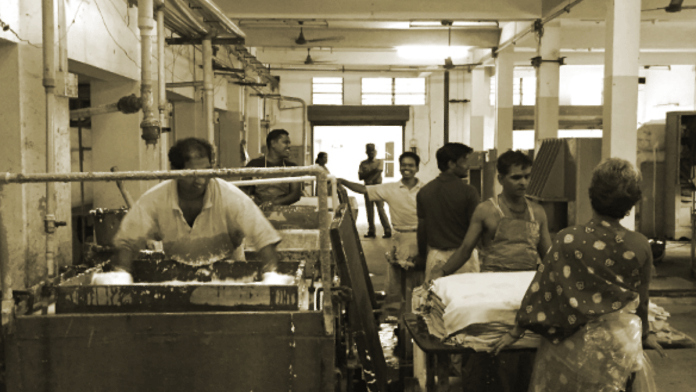Thank you dear subscribers, we are overwhelmed with your response.
Your Turn is a unique section from ThePrint featuring points of view from its subscribers. If you are a subscriber, have a point of view, please send it to us. If not, do subscribe here: https://theprint.in/subscribe/
We use paper to write, wrap, wipe, and other reasons. Our annual use of paper has increased by 56% since 1999.
Paper that was invented to write and draw started getting used for other purposes over the centuries. At present 85 % of mill made paper is wrapping paper, tissue paper and disposable containers. 75% of the paper produced either rots in mixed garbage or gets composted.
Though paper is compostable, this one item must never be composted but recycled. This can either be in mills or hand made paper making units. The former pollutes while the latter saves the environment. Thus the best option is to recycle it into handmade paper.
Mill made paper
Most of the mill made paper is made by stripping our land of trees. Tree cutting leads to erosion that pollutes soil by removing nutrient rich topsoil leaving behind less fertile soil and potentially exposing underlying layers that may contain pollutants.
To make a ton of mill made paper, seventeen trees are cut. These could be softwood trees like deodar and pine, hardwood trees like acacia and popular or fast growing trees like eucalyptus. The trees could be illegally cut from natural forests or they could be from monocultural agro forests that have taken over approximately 6.4 million hectares of land.
Paper mills are water guzzlers. A typical paper mill can use between 10 and 50 cubic meters of water per ton of paper produced during wood chip preparation, pulping, bleaching, and paper machine operations.
Paper mills pollute water through the discharge of wastewater containing chemicals, organic matter, and solids from processes like pulping and bleaching.
Chemicals like caustic soda, sodium sulfate, chlorine dioxide, hydrogen peroxide, calcium carbonate, sodium carbonate, aluminum sulfate, polyacrylamide, and sulfuric acid are used to break down lignin in wood fibers, pulping and bleaching processes leading to discharge of chemical waste water.
Paper mills pollute the air by releasing various pollutants like nitrogen oxides (NOx), sulfur oxides (SOx), volatile organic compounds (VOCs), particulate matter (PM), and odorous substances during the production process.
Handmade Paper
Making handmade paper is a decentralized activity. Handmade paper has character. It saves our soil,air and water from getting wasted or polluted. It replaces monoculture forests with multicultural forests. It creats green employment, lucrative businesses, small and medium sized entrepreneurs, exporters and eco friendly users.
Hand made paper can be made in villages, cities, panchayats, schools, colleges, offices and anywhere.
It’s a simple two step process. Collecting waste paper in baskets, receptacles, racks or store rooms. Installing a Pulper, Univat and Screw press in a small room with water and electric connection.
Waste paper torn into small pieces or shredded are soaked in water, converted into pulp in the Pulper, lifted on to the screen made of wooden frame and fine net/muslin cloth in the Univat, squeezing the excess water from wet sheets in the screw press and drying the sheets in sun.
Paper to be used for writing has to be calendered in a calendering machine and cut to size in a cutting machine either in situ or some printer.
To repeat the process at household level pulper is replaced with a mixi, Univat with a regular tub and screw press with a stone slab. For drawing, art, craft and cards used as such. For writing purposes paper would need to be ironed with a regular iron.
An appeal
Let’s make students, teachers, shop keepers, office goers and housewives conscious of the paper they use, write on both sides of the sheet, never throw any bit of the paper in garbage, acquire handmade paper making skills and become entrepreneurs with their visiting cards and personal stationery of hand made paper.
Schools must set up hand made paper making units and make this as an extracurricular activity. The sheets made must be used for making art copies, school stationery, printing reports and magazines, and innovative products.
Abettors
Khadi and Village Industries Commission ( KVIC) support the development of handmade paper units in the country.
Sanganer Jaipur has Kumarappa National Handmade Paper Institute for the revival and strengthening of Indian handmade paper industry.
TARA the Society for Technology & Action for Rural Advancements is a social enterprise of the Development Alternative Group. Its vision is to create sustainable livelihoods on a large scale, eradicate poverty and regenerate the environment. It has designed a week or 10 day training module on making hand made paper and paper products at a nominal cost.
Last Words
Be conscious of the paper you use.Do not abuse paper. Use handmade paper. Set your handmade paper making unit, get trained and start making handmade paper. Become an entrepreneur, create jobs and save the soil, water and air from pollutants. If not that, at least pledge to only buy handmade paper.
These pieces are being published as they have been received – they have not been edited/fact-checked by ThePrint


